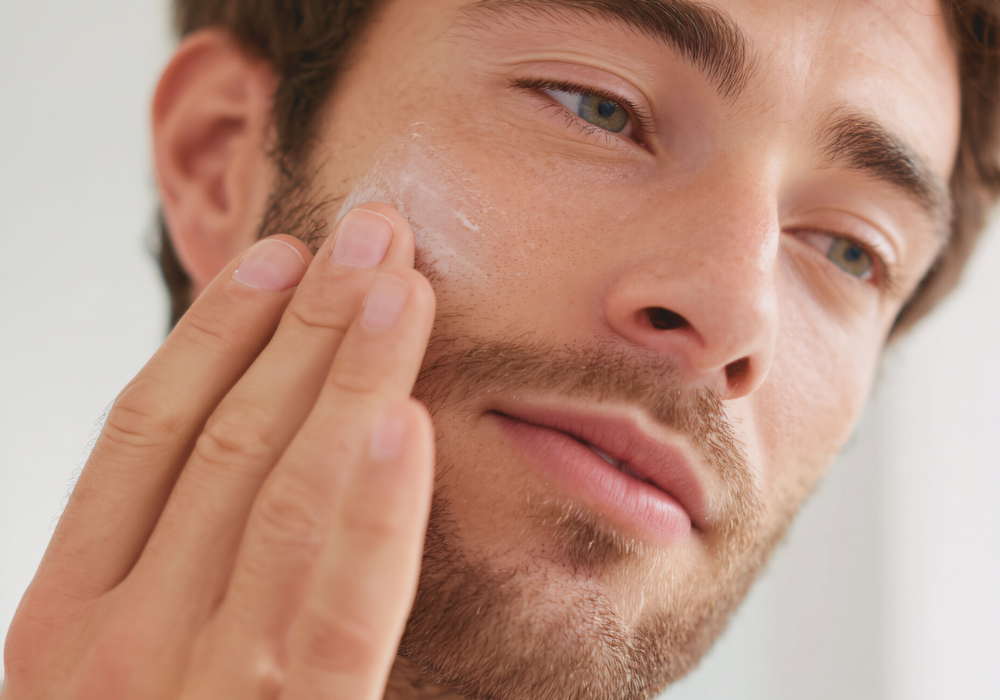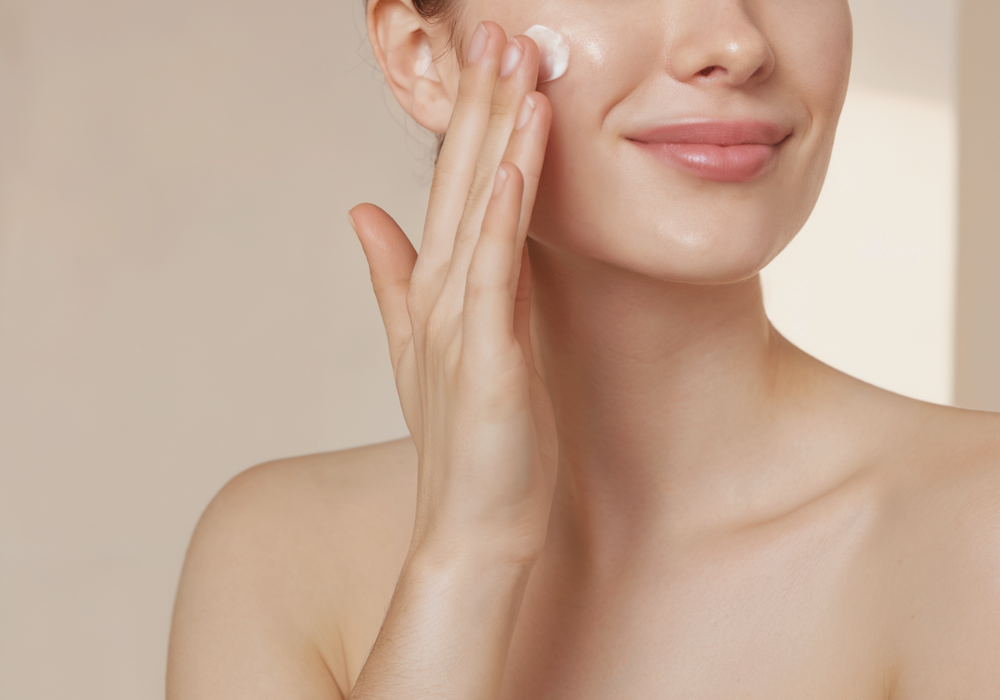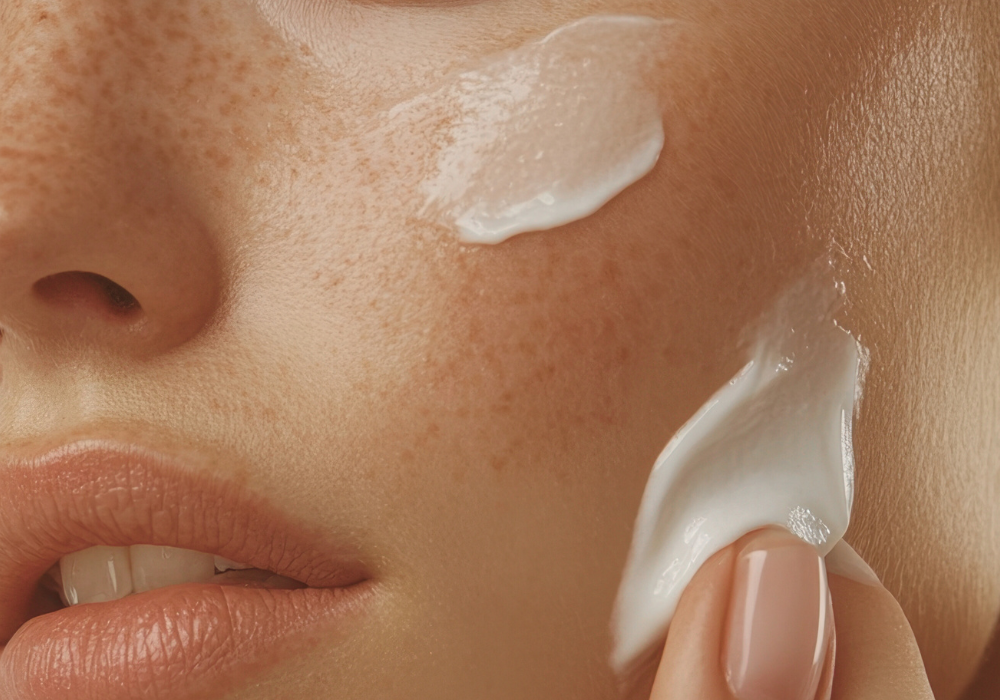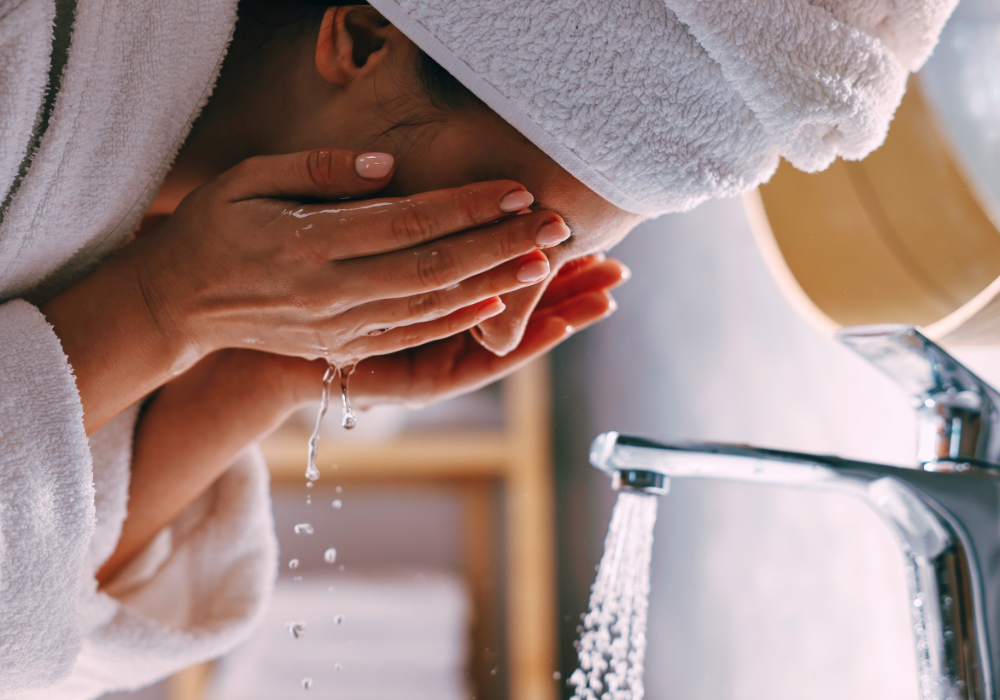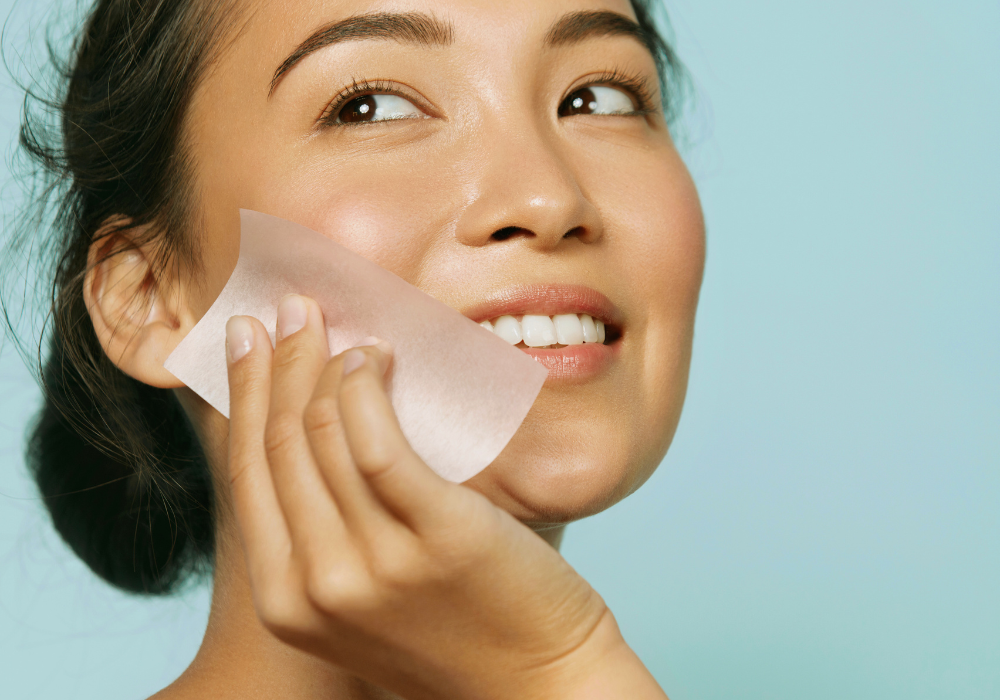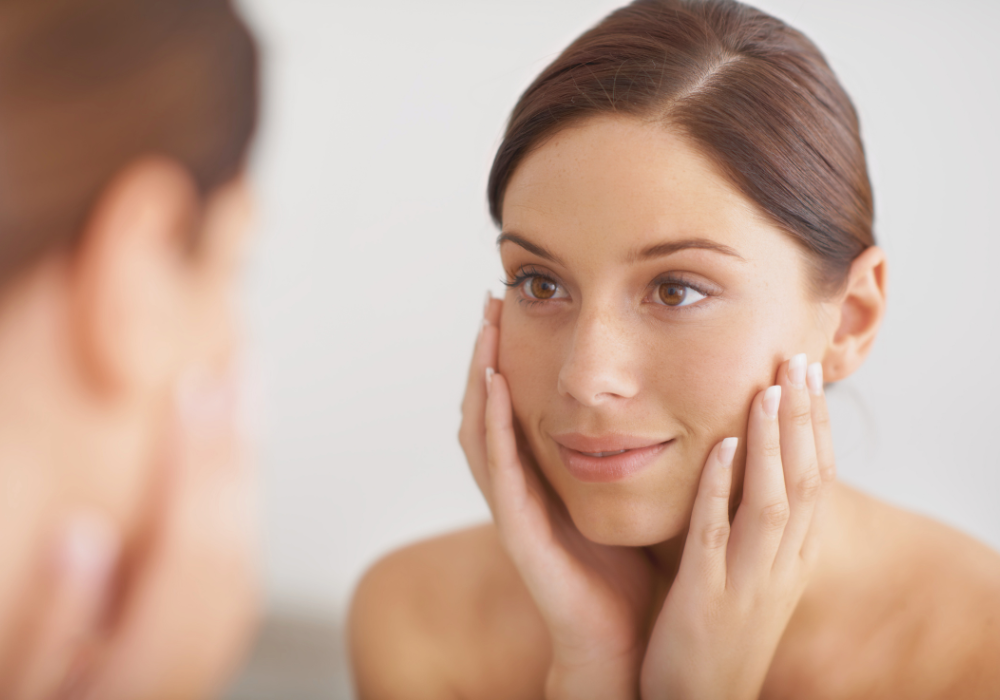Your skin sheds 500 million dead cells every day, but as you age, this natural renewal process slows dramatically—leading to dull, rough texture and clogged pores. Men face unique challenges: skin that's 10-20% thicker than women's, double the sebum production, and chronic stress from averaging 16,000 shaves in a lifetime. An exfoliating daily cleanser addresses these specific concerns by removing dead cell buildup, unclogging pores, and smoothing texture without complicated routines or aggressive scrubbing.
Key Takeaways
-
Men's skin produces roughly twice the oil of women's skin, making regular exfoliation essential for managing excess sebum and enlarged pores
-
Skin cell turnover slows from 28 days in youth to 50+ days by age 50, causing visible dullness and texture issues
-
Chemical exfoliants with AHAs and BHAs deliver significant improvements in skin texture (20%), pores (28%), and tone (29%) within 4 weeks
-
Up to 40% of men experience shaving-related skin problems that exfoliation helps prevent
-
Over 50% of U.S. men now use facial skincare products, representing a 68% increase since 2022
Why Men's Skin Demands Different Solutions
Male skin isn't just thicker—it's fundamentally different in ways that impact how you should approach skincare. The higher testosterone levels men have create approximately 20% more skin thickness and a tighter, firmer structure. This sounds beneficial until you consider what comes with it: more active sebaceous glands producing roughly double the oil, resulting in shinier skin with larger pores and lower pH levels.
This increased oil production makes men more prone to acne and impurities that accumulate throughout the day. Dead skin cells that would naturally shed get trapped in this excess sebum, creating an environment where pores become visibly clogged and skin texture turns rough. The problem compounds with shaving—each pass of the razor removes the uppermost layer of skin cells, exposing immature, sensitive skin underneath.
The biological reality creates a simple equation: more oil + slower cell turnover with age + regular shaving stress = skin that needs consistent exfoliation to maintain clarity and smoothness.
The Science Behind Cell Turnover and Aging
Understanding how your skin renews itself explains why exfoliation becomes increasingly important as you age. New skin cells form in the basal layer of your epidermis and migrate upward over approximately 28 days in young adults before shedding from the surface. This natural cycle keeps skin looking fresh and vibrant.
The process deteriorates with time. By age 50, this cycle extends to 50+ days, and in mature skin may take up to 90 days. Dead cells accumulate on the surface, creating:
-
Visible dullness and loss of natural glow
-
Rough, uneven texture you can feel
-
Increased vulnerability to acne as pores clog
-
Reduced effectiveness of other skincare products
-
Fine lines appearing more pronounced
Simultaneously, your skin's collagen production declines approximately 1% per year after age 30. This combination of slower renewal and structural protein loss creates the texture and tone changes most men notice in their 30s and 40s.
Chemical exfoliation counteracts this slowdown by dissolving the bonds holding dead cells together, accelerating turnover back toward more youthful rates without the skin damage that aggressive physical scrubbing causes.
Chemical vs. Physical Exfoliation: What Works Better
Not all exfoliation delivers the same results. The method you choose determines both effectiveness and safety for daily use.
Physical Exfoliation uses abrasive particles or tools to manually scrub away dead cells. While this feels satisfying and shows immediate smoothness, it carries significant risks:
-
Irregular particles (walnut shells, apricot kernels) create micro-tears in skin
-
Over-aggressive scrubbing damages the skin barrier
-
Results remain superficial, affecting only the outermost layer
-
Daily use typically causes irritation and inflammation
Chemical Exfoliation uses acids to dissolve cellular bonds at a molecular level. This approach offers several advantages for men's thicker, oilier skin:
-
Works beneath the surface to unclog pores from within
-
Doesn't require physical pressure that can irritate
-
Provides consistent results without technique variation
-
Can be formulated for gentle daily use at appropriate concentrations
The three main acid types serve different purposes:
-
Alpha-Hydroxy Acids (AHAs) like glycolic and lactic acid work on the skin's surface to brighten complexion and smooth texture. They're particularly effective for addressing dullness and age-related concerns but temporarily increase UV sensitivity.
-
Beta-Hydroxy Acids (BHAs) like salicylic acid are lipid-soluble, allowing them to penetrate oil-filled pores and dissolve debris. This makes them superior for oily, acne-prone skin without the photosensitivity concerns of AHAs.
-
Polyhydroxy Acids (PHAs) like gluconolactone deliver gentler exfoliation while simultaneously hydrating skin—ideal for sensitive skin types or those new to chemical exfoliants.
Building Your Simplified Skincare Routine
Effective men's skincare doesn't require 10+ products or complicated sequences. Research demonstrates that well-designed routines with 5-6 strategic products significantly outperform minimal 2-product approaches, with improvements visible in as little as 4 weeks.
Your essential morning routine:
-
Cleanse – Remove overnight oil and debris (2-3 minutes)
-
Moisturize – Hydrate based on your skin type (30 seconds)
-
Protect – Apply broad-spectrum SPF 30+ (30 seconds)
Your essential evening routine:
-
Cleanse with Exfoliant – Use daily if light exfoliant
-
Treat – Apply any targeted serums if needed (1 minute)
-
Moisturize – Restore hydration (30 seconds)
This streamlined approach takes under 10 minutes daily while addressing the core concerns men face: excess oil, texture, and protection against environmental damage. The key lies in product quality and consistency rather than quantity.
How to Choose Your Exfoliating Cleanser
Selecting the right product depends on your specific skin characteristics and concerns.
For Oily and Acne-Prone Skin: Look for cleansers with salicylic acid (BHA) at 0.5-2% concentration. This ingredient penetrates oil-filled pores to remove debris while providing anti-inflammatory benefits. It won't increase sun sensitivity, making it practical for morning use.
For Dry and Aging Skin: Choose formulations with lactic acid or glycolic acid (AHA) at 5-8% concentration. These work on the surface to improve texture and brightness while supporting collagen synthesis with regular use. Pair with hydrating ingredients like hyaluronic acid to prevent dryness.
For Combination Skin: Seek products combining multiple acid types at lower concentrations. A blend of AHA, BHA, and PHA provides comprehensive exfoliation that addresses both oily zones (typically T-zone) and drier areas without over-treating either.
For Sensitive Skin: Start with polyhydroxy acids (PHAs) or enzyme-based exfoliants. These deliver gentler action that's less likely to trigger irritation while still removing dead cell buildup effectively.
Essential quality indicators to verify:
-
Clear ingredient listing with specific acid concentrations
-
pH level between 3-4 for chemical exfoliants
-
Fragrance-free formulations if you have sensitivity
-
Non-comedogenic labeling to prevent pore clogging
-
Inclusion of soothing ingredients like panthenol or allantoin
Proper Application Technique Matters
How you use your exfoliating cleanser determines results as much as which product you choose.
Step-by-Step Application:
-
Wet your face with lukewarm water—not hot, which strips natural oils
-
Dispense a nickel-to-quarter-sized amount into your palm
-
Apply to damp skin using gentle circular motions for 30-60 seconds
-
Focus on areas with enlarged pores or rough texture (typically T-zone)
-
Rinse thoroughly with lukewarm water until all product is removed
-
Pat face dry with a clean towel—don't rub vigorously
Timing Considerations:
Evening use works better for AHA-containing products since it minimizes daytime UV exposure risk. For men who shave, apply exfoliating cleanser before shaving to lift hairs and clear debris, but allow 2-3 minutes between cleansing and shaving for skin to calm.
Warning Signs of Over-Exfoliation:
-
Persistent redness lasting more than 2 hours after cleansing
-
Burning or stinging sensation when applying other products
-
Increased dryness or flaking despite moisturizer use
-
Paradoxical increase in breakouts
-
Tight, uncomfortable skin sensation
If you experience these symptoms, reduce frequency immediately and focus on gentle, hydrating cleansers until your skin barrier recovers.
Key Ingredients That Deliver Results
Understanding what goes into your cleanser helps you make informed choices based on evidence rather than marketing claims.
Triple-Action Hydroxy Acids: A combination approach using AHA (1%), BHA (0.4%), and PHA (1%) provides comprehensive exfoliation. The AHA complex from citrus extracts brightens complexion, BHA refines texture and removes debris, while PHA simultaneously exfoliates and hydrates. Research shows this multi-acid strategy delivers better results than single-acid formulations while maintaining tolerability.
Charged Hyaluronic Acid: Next-generation hyaluronic acid engineered with a positive charge enhances water molecule binding to skin. At 0.1% concentration, this delivers lasting hydration even after rinsing, resulting in plumper, smoother skin that stays moisturized throughout the day.
Provitamin B5 (Panthenol): At 1% concentration, panthenol soothes skin and supports barrier function. This becomes particularly important for men who shave, as it helps calm post-shave irritation while promoting faster healing of micro-damage from razor blades.
Moisture-Locking Natural Sugars: Compounds like xylitol and xylitylglucoside form a hydrating matrix on skin's surface, optimizing water reserves and improving barrier function. This prevents the tight, dry feeling some exfoliants cause.
Ingredients to Avoid:
-
High concentrations of alcohol (causes unnecessary dryness)
-
Harsh sulfates like sodium lauryl sulfate (strips natural oils)
-
Large fragrance amounts high on ingredient lists (irritation risk)
-
Physical exfoliating particles with irregular edges
Addressing Common Men's Skin Concerns
Exfoliation tackles the specific issues men encounter most frequently.
-
Excess Oil and Shine: The higher sebum production in male skin creates persistent shine, especially in the T-zone. BHA exfoliants work within oil-filled pores to dissolve blockages and help regulate sebum secretion without triggering rebound oil production that harsh cleansers cause.
-
Ingrown Hairs and Razor Bumps: Regular exfoliation removes the dead skin cells that trap hair follicles, a common problem for men with coarse or curly facial hair. This prevents the painful, inflamed bumps that develop when hairs grow back into skin instead of breaking through the surface.
-
Enlarged Pores: While you can't permanently shrink pore size (it's genetically determined), exfoliation removes the debris and dead cells that make pores appear larger. Clinical assessments show 28% improvement in pore appearance after just 4 weeks of consistent use.
-
Dull, Rough Texture: The combination of slower cell turnover and accumulated dead cells creates rough, bumpy skin that looks tired. Exfoliating cleansers accelerate renewal cycles, revealing fresher cells underneath and restoring natural luminosity. Studies demonstrate 20% improvement in skin texture within the same timeframe.
Sun Protection Is Non-Negotiable
If your exfoliating cleanser contains alpha-hydroxy acids, daily sunscreen becomes mandatory—not optional. The FDA specifically warns that AHAs increase skin's sun sensitivity and sunburn risk, with this vulnerability persisting up to a week after discontinuing use.
This heightened photosensitivity occurs because AHAs thin the stratum corneum (outermost skin layer), reducing your natural UV protection. Without proper sun protection, you risk:
-
Severe sunburn from routine sun exposure
-
Accelerated photoaging and premature wrinkles
-
Hyperpigmentation and uneven skin tone
-
Increased long-term skin cancer risk
Men over 50 already face higher melanoma risk than the general population, making sun protection doubly important when using exfoliating products.
Essential Sun Protection Protocol:
-
Apply broad-spectrum SPF 30+ every morning
-
Reapply every 2 hours when outdoors
-
Use sunscreen even on cloudy days (UV penetrates clouds)
-
Consider using AHA exfoliants only in evening routines
-
Choose mineral sunscreens if chemical filters irritate your skin
Beta-hydroxy acids like salicylic acid don't carry this same photosensitivity concern and may actually provide some photoprotective benefits, making them a safer choice for men concerned about sun exposure.
Why Kipi's Exfoliating Daily Cleanser Stands Apart
While multiple exfoliating cleansers exist in the men's grooming market—which reached $61.62 billion in 2024—Kipi's approach delivers specific advantages for men seeking simplified, science-backed skincare.
The formula combines triple-action hydroxy acids (1% AHA Complex, 0.4% BHA, 1% PHA) addressing multiple concerns in a single step: exfoliation, pore refinement, and hydration. This multi-functional design eliminates the need for separate exfoliating products, cleansers, and hydrating treatments.
What Makes Kipi Different:
-
Engineered for Skin Biology: The 0.4% salicylic acid concentration specifically targets the higher sebum production and larger pores men experience
-
Charged Hyaluronic Acid Technology: Next-generation 0.1% hyaluronic acid with positive charge maintains hydration even after rinsing, preventing the tight, dry feeling some exfoliants cause
-
pH-Balanced at 4.5-5.5: Formulated at skin's natural pH to maintain effectiveness without disrupting the skin barrier or microbiome
-
Lightweight, TSA-Approved Format: The 60ml size provides approximately 2 months of use and fits carry-on restrictions for men who travel
-
Complete Transparency: Clear ingredient listing with specific concentrations, vegan and cruelty-free certification, sulfate and paraben-free formulation
Customer results support the formulation's effectiveness. Users report skin that glows after first use, complete makeup removal capability, and improved skin texture that prompts others to ask about their routine.
For men seeking premium skincare simplified, Kipi delivers science-backed results without complicated multi-step regimens. The cleanser works as part of a streamlined routine: cleanse, moisturize, and protect in the morning; cleanse with exfoliation 2-3 times weekly in the evening.
Learn more about the complete formulation or explore how science-backed skincare can simplify your routine while delivering visible results.
Frequently Asked Questions
Can I use an exfoliating cleanser every day without damaging my skin?
Yes, Kipi’s Daily Exfoliator is gentle enough for everyday use. Unlike harsh scrubs or strong chemical exfoliants, Kipi’s formula is designed with mild, skin-friendly ingredients that smooth and renew the skin without causing irritation or barrier damage. Its balanced blend of exfoliating and hydrating components makes it suitable for daily use—even for sensitive skin types—leaving your complexion fresh, soft, and radiant.
Should I use an exfoliating cleanser before or after shaving?
Apply your exfoliating cleanser before shaving for optimal results. Exfoliating before shaving lifts facial hairs and removes dirt and dead skin cells from the surface, allowing razors to glide more smoothly and cut hairs cleanly rather than tugging on them. This process significantly reduces razor bumps, burns, and ingrown hairs that affect up to 40% of men who shave regularly. Wait 2-3 minutes between cleansing and shaving to allow skin to calm, then proceed with your normal shaving routine.
Do I need to use sunscreen if my exfoliating cleanser contains AHAs?
Yes, daily broad-spectrum SPF 30+ sunscreen is mandatory when using AHA-containing products. The FDA specifically warns that alpha-hydroxy acids increase skin's UV sensitivity and sunburn risk, with this vulnerability persisting up to a week after discontinuing use. Apply sunscreen every morning, reapply every 2 hours when outdoors, and use protection even on cloudy days as UV rays penetrate clouds. Beta-hydroxy acids (BHAs) like salicylic acid don't carry this same photosensitivity concern.
How long does it take to see results from an exfoliating cleanser?
Initial improvements in skin texture and brightness typically appear within 2-4 weeks of consistent use at appropriate frequency. Clinical studies show measurable improvements in pore appearance (28%), skin tone (29%), and texture (20%) after 4 weeks, with optimal results developing over 8-12 weeks. However, results require patience and consistency—sporadic application yields minimal benefits while regular routine adherence (2-3 times weekly) delivers cumulative improvements in skin health and appearance.
Can exfoliating cleansers help prevent ingrown hairs and razor bumps?
Yes, regular exfoliation effectively prevents ingrown hairs by removing the dead skin cells that trap hair follicles beneath the surface. This is particularly beneficial for men with coarse or curly facial hair who are more prone to hairs growing back into skin instead of breaking through. The process also smooths skin texture, allowing razors to glide more easily and cut hairs cleanly, which reduces razor bumps and irritation. For optimal results, exfoliate before shaving and use products containing salicylic acid (BHA), which penetrates pores to clear debris and provide anti-inflammatory benefits that soothe post-shave irritation.
